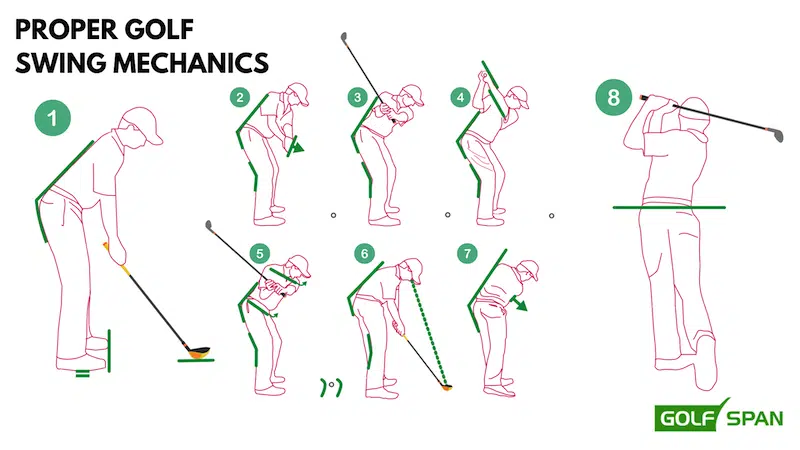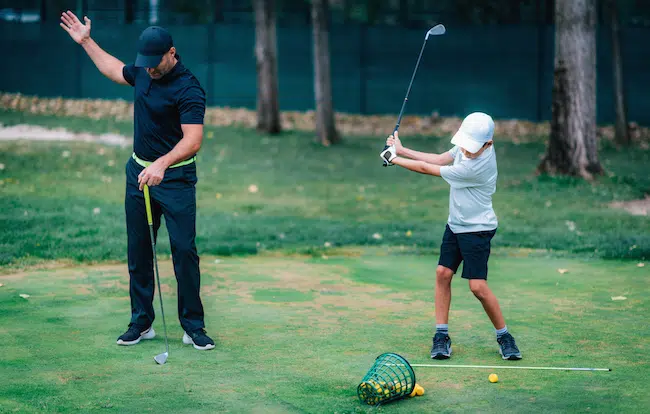The perfect golf swing sequence is the key to unlocking your full potential on the golf course. It influences the accuracy and distance of your shots and enhances your overall playing experience.
Here are the steps to an ideal golf swing sequence:
- Setup and address
- Takeaway
- Backswing
- Transition
- Downswing
- Impact
- Follow-through
- Finish
But to lower your golf score, you’ll need more details about how to improve at each step. If you miss one little piece, you may never be able to reach your golf potential.
This comprehensive guide will explore the golf swing sequence’s various components, providing valuable insights, tips, and drills to help you refine your technique and elevate your game to new heights.
What is a Golf Swing Sequence?

A golf swing sequence is a series of coordinated movements that golfers perform when striking the ball. This sequence can be broken down into different phases, each playing a crucial role in the overall swing.
By understanding and mastering each of these phases of how to swing a golf club, you can improve your overall swing sequence golf performance and see tangible results on the course.
- Setup and address: The foundation of your swing starts here, with the correct body posture, grip, and alignment with the ball. Paying attention to these details will set you up for success throughout the rest of the swing sequence.
- Takeaway: The initial movement of the club as you start your backswing is critical in setting the stage for a proper swing plane and rhythm.
- Backswing: The full rotation of your upper body as you bring the club back, preparing for the downswing, allows you to generate power and create an optimal swing path.
- Transition: The change of direction from the backswing to the downswing is a crucial moment in the golf swing sequence. Proper weight shift and body rotation will ensure you’re poised for a powerful, accurate shot.
- Downswing: As you initiate the downswing, you’ll generate speed and power by releasing stored energy from your backswing. Proper sequencing of your hips, torso, and arms is essential for a successful downswing.
- Impact: The moment of truth in your swing, where the clubface makes contact with the ball. Proper body position, clubface angle, and swing path will determine the quality of your shot.
- Follow-through: The culmination of your swing, where you maintain balance and posture while observing your shot’s flight.
- Finish: A smooth, controlled follow-through represents the final piece of the golf swing sequence puzzle.
Why is the Golf Swing Sequence Important?

Mastering the golf swing sequence is vital for several reasons:
Consistency in Performance
A uniform swing sequence enables golfers to produce dependable shots and sustain a stable handicap. Adhering to the same set of movements with each swing reduces variability in your shots, which is crucial for scoring well and maintaining a solid game.
- Predictable ball flight: A consistent swing sequence allows for better prediction of the ball’s flight path, making club selection and shot planning easier.
- Improved shot-making: Consistency in your swing sequence leads to more solid contact with the ball, resulting in enhanced shot-making and lower scores.
Injury Prevention
The proper golf swing sequence minimizes injury risk by alleviating unnecessary bodily strain. Golfers who consistently employ the correct swing sequence are less prone to developing chronic injuries that can impede progress and enjoyment of the game.
- Reduced strain on joints and muscles: Following the correct golf swing sequence helps distribute the forces generated during the swing evenly throughout your body, preventing excessive strain on specific joints or muscles.
- Lower risk of back pain: Many golfers experience back pain due to poor swing mechanics. Nevertheless, adopting the proper golf swing sequence can significantly help reduce it by promoting a more efficient and balanced swing.
Swing Accuracy and Distance
Following the correct golf swing sequence allows golfers to better control the ball’s direction and distance. The proper sequence ensures that your clubface is square at impact and your swing path is optimal–both vital for accurate and long shots.
- Improved shot dispersion: A consistent golf swing sequence decreases variability in your shots, resulting in a tighter shot dispersion and enhanced accuracy.
- Better control of trajectory: Mastering the golf swing sequence allows you to control the trajectory of your shots more effectively, helping you navigate challenging course conditions and hit more precise shots.
The Ideal Golf Swing Sequence Explained
In this section, I’ll explain the step-by-step golf swing sequence, provide insights into the proper golf swing sequence for iron shots, and discuss frame-by-frame golf swing sequence analysis. We’ll also cover common mistakes, ways to correct them, and advanced concepts for further improvement.
Step-by-Step Golf Swing Breakdown
- Setup and address: Position yourself in front of the ball with your feet shoulder-width apart, knees slightly bent, and weight distributed evenly. Align your clubface with the ball and grip the club comfortably.
- Takeaway: Begin your swing by slowly moving the clubhead back, keeping it low to the ground. Your arms should remain straight, and your shoulders should start to rotate.
- Backswing: Continue moving the club back, maintaining a steady tempo. Your left arm should remain straight, and your right elbow should fold as the club reaches parallel to the ground. Your hips should also begin to rotate. To improve your golf swing sequence, consider focusing on your hip turn.
- Transition: This is the moment when your backswing concludes, and your downswing commences. It’s essential to shift your weight smoothly from your back to your front foot while your hips rotate toward the target.
- Downswing: As your hips persist in their rotation, your arms should trail subtly, guiding the club downwards toward the ball. Keep your left wrist flat and maintain a slight bend in your right wrist.
- Impact: During impact, your clubface must make square contact with the ball. Your hips ought to be open, with most of your weight resting on your front foot.
- Follow-through: Post-impact, continue the rotation of your hips and shoulders, letting the club move naturally around your body.
- Finish: Keep your arms extended and ensure your weight is transferred entirely to your front foot.
Proper Golf Swing Sequence for Irons
To execute an effective golf iron swing sequence, maintain a marginally steeper swing plane and guarantee proper weight transfer. Position the ball in the center of your stance and place your hands slightly ahead of the ball at the address. This setup promotes a downward strike, crucial for achieving solid iron shots.
Frame-by-Frame Golf Swing Sequence Analysis
To truly understand and perfect your golf swing sequence, consider recording your swing and analyzing it frame by frame. This allows you to identify any flaws or inconsistencies in your technique, making correcting them easier and improving your overall swing.
Common Golf Swing Sequence Mistakes and Corrections
- Rushing the takeaway: Rushing the takeaway can cause a loss of control and rhythm. Focus on a smooth, controlled takeaway to set the stage for the rest of your swing.
- Excessive head movement: Moving your head too much during the swing can disrupt your balance and make consistent contact difficult. Keep your head steady and maintain eye contact with the ball.
- Improper weight transfer: Failing to transfer your weight correctly can lead to weak, off-center shots. Practice shifting your weight smoothly from your back foot to your front foot throughout the swing.
Advanced Concepts for Golf Swing Sequence Improvement
- Swing plane: The path your club travels on throughout your swing significantly impacts your shot quality. Experiment with different swing planes to find the one that best suits your body type and swing style.
- Clubhead lag: Creating and maintaining clubhead lag during the downswing can help generate more power and accuracy in your shots. Practice delaying the release of the clubhead until just before impact.
- Body rotation and sequencing: The proper sequencing of your body rotation during the swing can significantly impact your swing efficiency and power. Work on coordinating your hips, torso, and arms to create a smooth and powerful swing.
If you’re looking to improve your golf swing sequence, you may want to pay attention to your right arm and elbow.
Golf Swing Progression Tips

To achieve the correct golf swing and improve your game, consider these tips for each aspect of your swing progression.
Correct Golf Swing Mechanics
- Maintain a proper grip: The grip lays the foundation for your swing. Grasp the club with a neutral grip, making certain your hands are neither too strong nor too weak.
- Keep your head steady: Refrain from excessive movement in your head during the swing. This helps maintain balance and promotes a consistent swing path.
Golf Swing Sequence Drills and Exercises
- The takeaway drill: Practice your takeaway by placing a club on the ground parallel to your target line. As you initiate your swing, maintain the clubhead low and aligned with the club on the ground.
- The one-arm drill: Engage in practice swings using only your lead arm to amplify arm extension and body rotation throughout the swing.
- The impact bag drill: Refine your impact position and acquaint yourself with the feeling of solid contact by practicing strikes on an impact bag.
Read more: Simple Strike Sequence Review
Equipment Considerations
- Choose the right clubs: Opt for clubs that complement your swing speed, skill level, and physical abilities. Custom-fitted clubs can substantially enhance your performance.
- Use proper golf balls: Golf balls exhibit diverse levels of spin, distance, and feel—try various types to discover the ideal match for your game.
- Wear appropriate footwear: Golf shoes with excellent traction and support can boost your stability during the swing and help you maintain balance.
Mental Strategies for Golf Swing Progression
- Visualization: Practice visualizing the ideal swing sequence in your mind before executing the swing. This can help reinforce good habits and increase confidence.
- Pre-shot routine: Establish a consistent pre-shot routine to help calm nerves and ensure a smooth transition from practice swings to actual shots.
- Focus on the process: Concentrate on the individual components of your swing rather than the shot’s outcome. This can help reduce pressure and improve overall swing mechanics.
FAQs
How Can I Improve My Golf Swing Sequence?
Improving your golf swing sequence requires practice, patience, and attention to detail. Start by mastering the fundamentals of grip, stance, and alignment.
Work on each phase of the swing and consider using drills and exercises to reinforce good habits. Lastly, don’t be afraid to seek professional advice or use technology to analyze and fine-tune your swing.
What Are The Common Golf Swing Sequence Mistakes?
Some common golf swing sequence mistakes include rushing the takeaway, excessive head movement, improper weight transfer, and over-swinging. We highly recommend getting tip guides on weight shifting for this case.
These errors can lead to inconsistent shots and reduced power. Identifying and correcting these mistakes can significantly improve your swing.
Can The Golf Swing Sequence Vary Between Different Clubs?
Yes, while the basic principles of the golf swing sequence remain consistent across all clubs, there are some minor variations depending on the club you’re using.
For example, the swing plane for irons is generally steeper than that of woods, and the ball position at the address may differ between clubs.
How Can I Incorporate My Lower Body More Effectively In The Golf Swing Sequence?
Establish a solid base during the setup to effectively incorporate your lower body in the golf swing sequence. Ensure your feet are shoulder-width apart and your weight is evenly distributed between both feet, providing a stable foundation for your swing.
As you initiate the downswing, focus on rotating your hips towards the target, generating power from your lower body and facilitating energy transfer through your torso and into your arms.
Throughout the downswing, remember to shift your weight from your back foot to your front foot, allowing for a more powerful and controlled swing.
Conclusion
The golf swing sequence is necessary if you want to make it big in golf. Understanding its mechanics, dissecting it step by step, and incorporating suitable drills, exercises, and mental strategies will pave the way for a more consistent, forceful, and precise swing.
Remember that the keys to improvement are practice and patience, so persist in honing your swing and relish the benefits of an improved golf game.
Clint is PGA-certified and was a Head Teaching Professional at one of Toronto's busiest golf academies. He was also featured on Canada's National Golf TV program, "Score Golf Canada," twice. He graduated with a degree in Golf Management from the College of the Desert in California and studied under Callaway's co-founder, Tony Manzoni.
He has a handicap index of 6.2 and spends the winters near Oaxaca, Mexico, where he plays twice a month at the Club de Golf Vista Hermosa. He's written over 100 articles at GolfSpan since 2021. You can connect with Clint at LinkedIn, FB, his website, or Clintcpga@gmail.com.
- Best score: 68
- Favorite club: Odyssey White Hot Two-Ball Center-Shafted Putter
- Favorite ball: Titleist Pro V1x
- Favorite food at the turn: Hot dog







